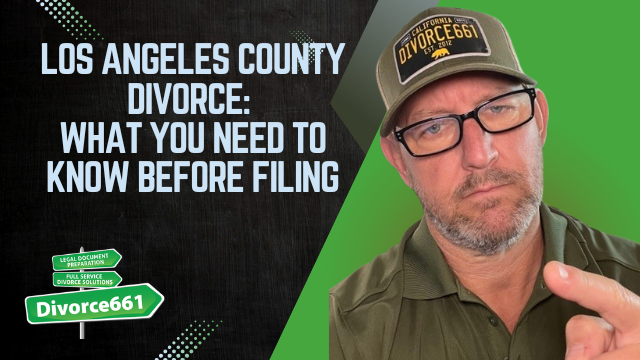Los Angeles County Divorce: What You Need to Know Before Filing
Thinking about filing for divorce in Los Angeles County? Before you take any steps, it’s crucial to understand the key requirements and common pitfalls that can delay or complicate the process. Tim Blankenship from Divorce661 breaks down the essentials you need to know before filing your divorce in LA County to help you avoid costly mistakes and ensure a smoother experience.
Residency Requirements: The First Step to Filing
Before filing for divorce in Los Angeles County, one important rule stands out: at least one spouse must have lived in California for a minimum of six months. Additionally, residency in Los Angeles County itself must be established for at least three months. Failing to meet these residency requirements means you’ll encounter a waiting period that can significantly delay your divorce.
Double-checking your residency status is essential to avoid unnecessary setbacks. Missing this step can stall the entire process, so it’s better to confirm residency before moving forward.
California’s No-Fault Divorce Policy Simplifies the Process
California follows a no-fault divorce policy, which means you don’t need to prove any wrongdoing or fault on the part of either spouse. Simply citing irreconcilable differences is enough to move forward with your divorce.
This approach is designed to reduce conflict and speed up divorce proceedings. By removing the need to prove fault, both parties can focus on resolving important issues like property division, child custody, and support, making the process less stressful and more straightforward.
Contested vs. Uncontested Divorce: Which One Applies to You?
Understanding whether your divorce is contested or uncontested can help you prepare for what lies ahead. Here’s a quick breakdown:
- Uncontested Divorce: Both parties agree on all terms, making this option quicker, less expensive, and less emotionally draining.
- Contested Divorce: Disagreements require court hearings, which can prolong the process and increase costs.
Whenever possible, opting for an uncontested divorce can save you significant time and reduce emotional strain during an already challenging period.
The Six-Month Waiting Period: When Does the Clock Start?
A common misconception is that the six-month waiting period begins the day you file your divorce paperwork. In reality, the clock starts only after your spouse has been formally served with divorce papers.
This detail is critical. For example, a client once thought her divorce was finalized, only to discover her spouse had never been served, meaning the six-month waiting period hadn’t even begun. Mistakes like this can cause frustrating delays.
How Divorce661 Can Help You Avoid Delays and Mistakes
Filing for divorce can be complex, but you don’t have to navigate it alone. Divorce661 specializes in handling everything from paperwork preparation and service to e-filing, ensuring your divorce process moves forward smoothly and efficiently.
By working with Divorce661, you can:
- File and serve all paperwork correctly the first time
- Avoid unnecessary court appearances
- Stay on track with flat-fee, 100% remote divorce services
To get started, visit divorce661.com for a free consultation and take the smart path to finalizing your divorce in Los Angeles County.
Conclusion
Filing for divorce in Los Angeles County involves clear residency requirements, understanding California’s no-fault divorce law, and knowing the difference between contested and uncontested cases. Remember, the six-month waiting period only begins after your spouse is served, not when you file. Avoid the common mistakes that delay divorce finalization by ensuring all steps are handled correctly from the start.
With the right guidance and support, you can navigate this challenging time more smoothly. Whether you’re just beginning or ready to file, make sure you’re informed and prepared to move forward efficiently.

